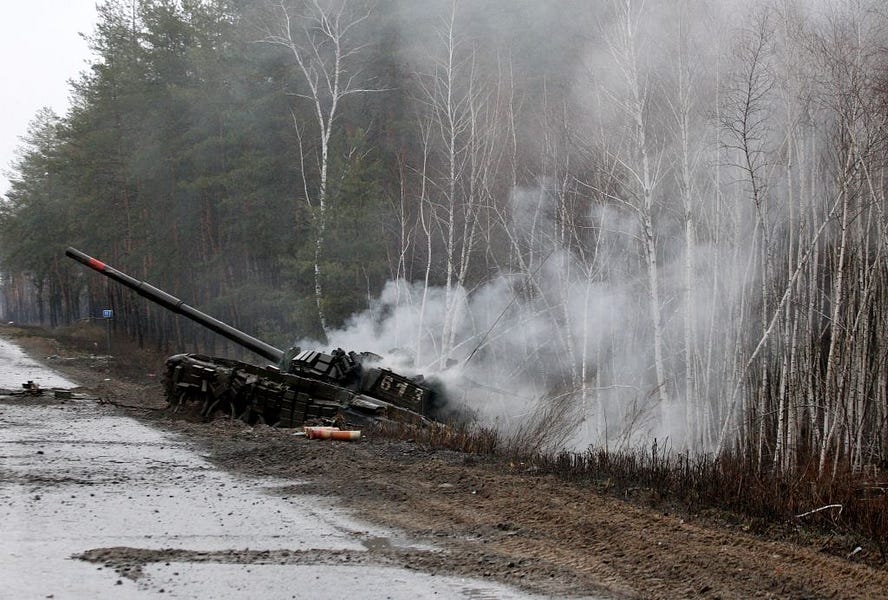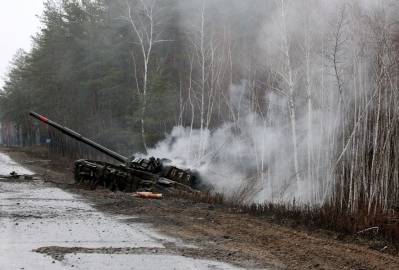Those watching news coverage of the Russian invasion of Ukraine will have heard by now of the vaunted Chechen fighters. Chechen leader and close Putin ally Ramzan Kadyrov has sent thousands of his soldiers—many of whom are veterans of Russia’s wars in Georgia and Syria—to suppress the Ukrainian resistance. They have an earned reputation for toughness, brutality, and tenaciousness, fighting under a flag bearing the image of a gray wolf, a traditional symbol of Chechen nationalism.
Putin’s decision to send the Chechen wolves to Ukraine was a warning to Ukrainian resistors, that “what happened in Chechnya will happen in Ukraine—that they’ll rampage the city, loot, rape, and kill.” Pro-Russian accounts on social media shared videos of bearded Chechen fighters marching to war accompanied by primal music and looking appropriately ferocious.
Thus far the Chechen impact on the war has been underwhelming. Ukrainian officials claimed last week to have defeated a Chechen strikeforce sent to assassinate President Volodymyr Zelensky and destroyed a column of Chechen tanks on its way to Kyiv. But for Putin, the propaganda value from sending in the Chechens was as much the point as any battlefield accomplishments. They were meant to scare Ukrainians into submission. The Chechens are coming! The Chechens are coming!
The Chechen soldiers in Ukraine are fulfilling a similar role to that once played by a different group of foreign mercenaries from American history. In Washington Irving's 1819 tale, The Legend of Sleepy Hollow, the superstitious schoolmaster Ichabod Crane is confronted by a ghost from America's revolutionary past. The villain of the piece, a saber-slashing “headless horseman,” could have easily been a British red coat, taking his revenge on those who had defied king and crown. Yet Irving chose differently, making his antagonist “the Galloping Hessian of the Hollow.”
It was a callback to the so-called Hessian mercenaries (who were really from a variety of German states and not just Hesse-Cassel) sent by the British to the rebellious colonies in 1776. Rumors about these Germans’ brutality spread quickly. They were supposedly loyal only to coin yet possessed a thirst for blood. Some called them “Hessian banditti” who would roast and eat small children, plunder their way across the countryside, and commit “rapes and brutalities...even on very young girls [that] would shock the ears of modesty.”
The reality was rather different. As one Hessian soldier noted in his diary, local civilians would visit, expecting “to see monsters” only to realize “that we looked like human beings.” In the end, the fearful prospect of these bloodthirsty Hessian mercenaries, meant to evoke the power and reach of the British empire, was just a story, as much a fiction as that of Irving’s Legend of Sleepy Hollow. The “Galloping Hessian” was a mere legend by the early 19th century and would be all but forgotten today but for Disney's 1949 animated film and subsequent remakes. Yet the fate of the Hessians during the American Revolution offers a series of sobering lessons for Chechen and Russian soldiers in Ukraine today.
First, Putin's Chechen gambit could severely backfire. The Kremlin is struggling with demoralization and desertion among its regular Russian army troops, many of whom have family ties to Ukraine and who share a similar language, religion, and cultural tradition with the people they are fighting. One of the major advantages of deploying the Chechens is the cultural distance between them and the Ukrainians; they talk differently, pray differently, and share no ethnic affinity. It should be easier for them to dehumanize their opponents. But sending in a force of foreign soldiers with a reputation for brutality risks energizing the Ukrainian opposition. Propaganda meant to intimidate can instead motivate.
The same was true of the American reaction to the Hessians in 1776. At the time, many colonists still thought of themselves as fundamentally English and were shocked, as recorded in the Pennsylvania Evening Post of March 30, 1776, that the king had employed mercenaries “who have no principle, either of honour, religion, public spirit, regard of liberty, or love of country.” Earlier that year, parliamentary critics of hiring the Hessians worried that the colonists would thus “come to understand that Great Britain is forming alliances, and hiring foreign troops for their destruction” and that this would ultimately encourage the revolutionaries “to avail themselves of the like assistance” from France or another European power.
Their apprehensions were soon realized. When Thomas Jefferson scribed the Declaration of Independence a few months later, he highlighted the “foreign Mercenaries” hired to “compleat the works of death, desolation and tyranny” as a key justification for leaving the empire. And before the year was out, Benjamin Franklin was aboard a ship seeking "like assistance" from France.
Second, despite their fearsome reputations, the Chechens risk as grim a fate as that of many Hessian soldiers in the colonies. By one estimate, of the nearly 30,000 troops sent from the various German states, a staggering 12,562 never returned home. Perhaps 5,000 of those died in battle, so many that years later a Continental Army veteran visiting the old battlefield at White Plains, New York, reported finding “Hessian sculls as thick as a bomb shell” laying on the ground, dug up and scraped clean by wild dogs and feral hogs. The soldier ruminated, “They were left unburied in a foreign land … forced to come and be killed here.”
One is reminded of the Ukrainian babushka confronting a bewildered Russian soldier early in the invasion, offering him sunflower seeds to put in his pocket “so they grow when you die.” Who knows how many of the tens of thousands of Chechen fighters sent to Ukraine will meet that fate, but some have already been “left unburied in a foreign land.”
Third, there is a hopeful note to sound even in that grim tale—and perhaps a hint of a smart strategy. For all the Hessians who died on American battlefields, nearly as many remained behind under kinder circumstances. Many Hessians who arrived in this lush, free land quickly realized they were fighting for the wrong side. Approximately 3,000 Hessians deserted during the course of the war, fully a tenth of the entire force.
That was in part the result of a policy choice, one of the earliest actions of the new Continental Congress. In August 1776, Congress commissioned agents of German ancestry to go and pass out handbills near Hessian encampments on Staten Island, offering them clemency if they deserted. More than a few absconded to the already established German immigrant settlements in Pennsylvania and the mid-Atlantic states. That led to growing frustration among the German princes in the old country as they struggled to find capable replacements in order to avoid defaulting on their mercenary contracts. It was a brilliant strategic decision. Whether dead on the battlefield in White Plains, New York, or alive and farming a field in Lancaster, Pennsylvania, it meant one fewer Hessian soldier in the fight for American independence.
A similar policy has been proposed today regarding Russian soldiers. Columnist David Frum suggested that Russian military deserters be offered a European Union or United Kingdom work visa “plus a free train ride to a job fair.” But why stop at the edge of the Atlantic Ocean? If Putin forces conscripts to risk death fighting their cousins in Ukraine, it will make the prospect of draft-dodging to go live abroad with their Russian-American cousins that much more attractive. Whether pushing up sunflowers on the outskirts of Kyiv or working as an automobile mechanic in Yonkers, it means one fewer Russian soldier in the fight for Ukrainian independence. And that would transform Putin’s disastrous misstep in Ukraine into a multi-generational boon for the United States.
When Washington Irving wrote The Legend of Sleepy Hollow, veterans of the Continental Army were starting to pass away. That filled the next generation with anxiety, a fear that they would forget that sacrifice and squander the legacy of the Revolution (though they argued constantly over what exactly that legacy was intended to be). Irving thought that the educated but unmoored Ichabod Crane—representative of this new generation of affluent, mobile, young Americans—needed to have a little sense scared into him by a headless Hessian horseman.
Right now, new myths and legends are being generated in Ukraine, like that of a sunflower-seed bearing babushka, a stoic comedian turned president, farmers stealing missile launchers with their tractors, and citizen militia taking up arms by the thousands to defend their homes. And one day, their children may tell tales of a headless Chechen, haunting Ukrainians who fail to remember their sacrifice.
Paul Matzko is a historian and research fellow at the Cato Institute.






Please note that we at The Dispatch hold ourselves, our work, and our commenters to a higher standard than other places on the internet. We welcome comments that foster genuine debate or discussion—including comments critical of us or our work—but responses that include ad hominem attacks on fellow Dispatch members or are intended to stoke fear and anger may be moderated.
With your membership, you only have the ability to comment on The Morning Dispatch articles. Consider upgrading to join the conversation everywhere.